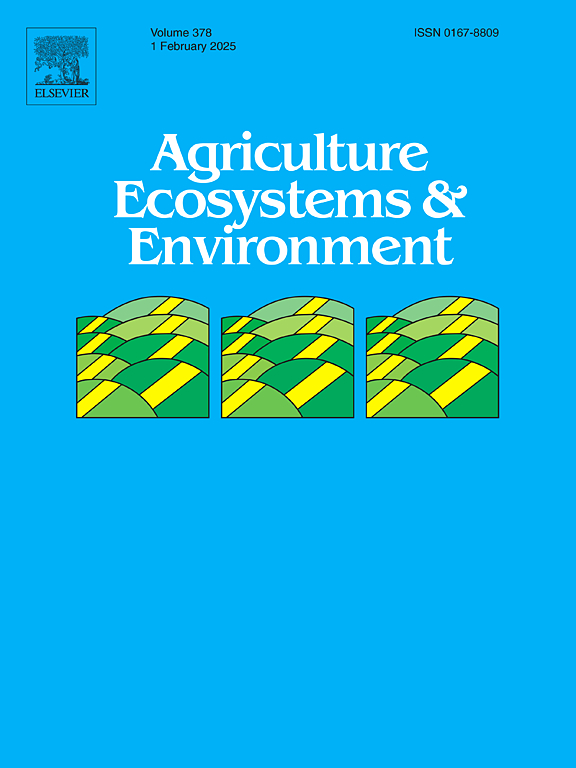Coupling soil bacterial and fungal community traits to multifunctionality in grassland ecosystem
IF 6
1区 农林科学
Q1 AGRICULTURE, MULTIDISCIPLINARY
引用次数: 0
Abstract
Understanding how bacterial and fungal community traits affect ecosystem functions, and thus provide ecosystem services, is becoming increasingly necessary. However, the relationship between microbial community traits and ecosystem multifunctionality, as well as the mechanisms underlying diversity and multifunctionality, remains a topic of concern. Here, we explored the bacterial and fungal communities and linked them with ecosystem multifunctionality (including enzymatic activity and nutrient pool) in continuous grassland ecosystems (desert, typical and meadow). We found a significant and positive correlation between abundance, diversity, network properties of bacteria and fungi and ecosystem multifunctionality. Bacterial and fungal diversities were the most important factor determining the multifunctionality in grassland ecosystems, whereas their abundance becomes more crucial than diversity in desert grasslands, where the abundances were as low as 1.11 × 107 and 3.67 × 106 copies g−1 soil for bacteria and fungi, respectively. The relative contributions of bacteria and fungi on multifunctionality changed along with grassland types, with the relative contributions of fungi increasing from desert (49.5 %) to typical (50 %), and to the meadow grasslands (67.8 %). Moreover, bacterial and fungal assembly processes were mainly determined by stochastic processes, especially in meadow grasslands, and the microbial assembly processes were significantly positively correlated with diversity-multifunctionality relationship (the correlation coefficients between α diversity and multifunctionality relationships). Taken together, our results reveal the importance of bacterial and fungal abundance and diversity in maintaining soil multifunctionality, and provide strong support for the relationship between assembly process and diversity-multifunctionality in grassland ecosystems.
草地生态系统土壤细菌和真菌群落特征与多功能性的耦合
了解细菌和真菌群落特征如何影响生态系统功能,从而提供生态系统服务,变得越来越有必要。然而,微生物群落特征与生态系统多功能性之间的关系以及多样性和多功能性的机制仍然是一个值得关注的话题。本文探讨了荒漠、典型和草甸连续草地生态系统中细菌和真菌群落与生态系统多功能性(包括酶活性和营养池)的关系。我们发现细菌和真菌的丰度、多样性、网络特性与生态系统多功能性之间存在显著正相关。细菌和真菌多样性是决定草地生态系统多功能性的最重要因素,而它们的丰度比荒漠草原的多样性更为重要,荒漠草原细菌和真菌的丰度分别低至1.11 × 107和3.67 × 106拷贝g−1。细菌和真菌对草地多功能性的相对贡献随草地类型的不同而变化,真菌的相对贡献从荒漠草地(49.5 %)到典型草地(50 %),再到草甸草地(67.8% %)依次增加。此外,细菌和真菌的组装过程主要由随机过程决定,特别是在草甸草原,微生物组装过程与多样性-多功能关系(α多样性与多功能关系的相关系数)呈显著正相关。综上所述,我们的研究结果揭示了细菌和真菌丰度和多样性在维持土壤多功能性中的重要性,并为草地生态系统组装过程与多样性多功能性之间的关系提供了强有力的支持。
本文章由计算机程序翻译,如有差异,请以英文原文为准。
求助全文
约1分钟内获得全文
求助全文
来源期刊

Agriculture, Ecosystems & Environment
环境科学-环境科学
CiteScore
11.70
自引率
9.10%
发文量
392
审稿时长
26 days
期刊介绍:
Agriculture, Ecosystems and Environment publishes scientific articles dealing with the interface between agroecosystems and the natural environment, specifically how agriculture influences the environment and how changes in that environment impact agroecosystems. Preference is given to papers from experimental and observational research at the field, system or landscape level, from studies that enhance our understanding of processes using data-based biophysical modelling, and papers that bridge scientific disciplines and integrate knowledge. All papers should be placed in an international or wide comparative context.
 求助内容:
求助内容: 应助结果提醒方式:
应助结果提醒方式:


